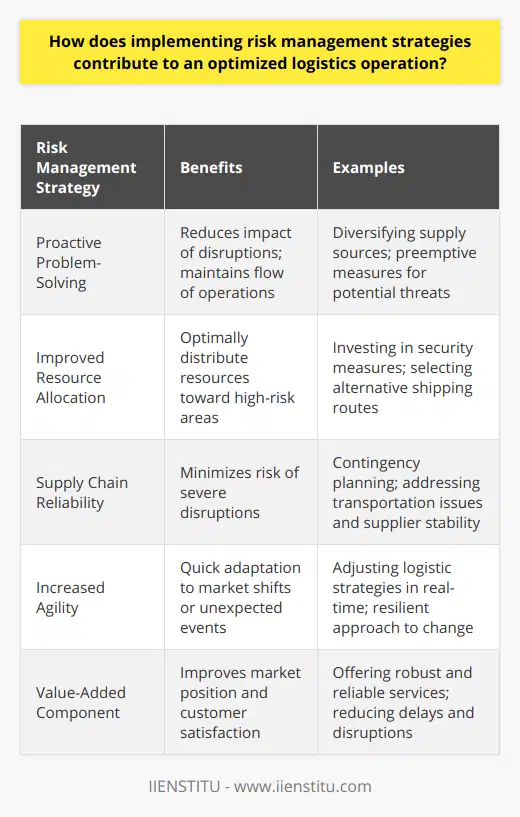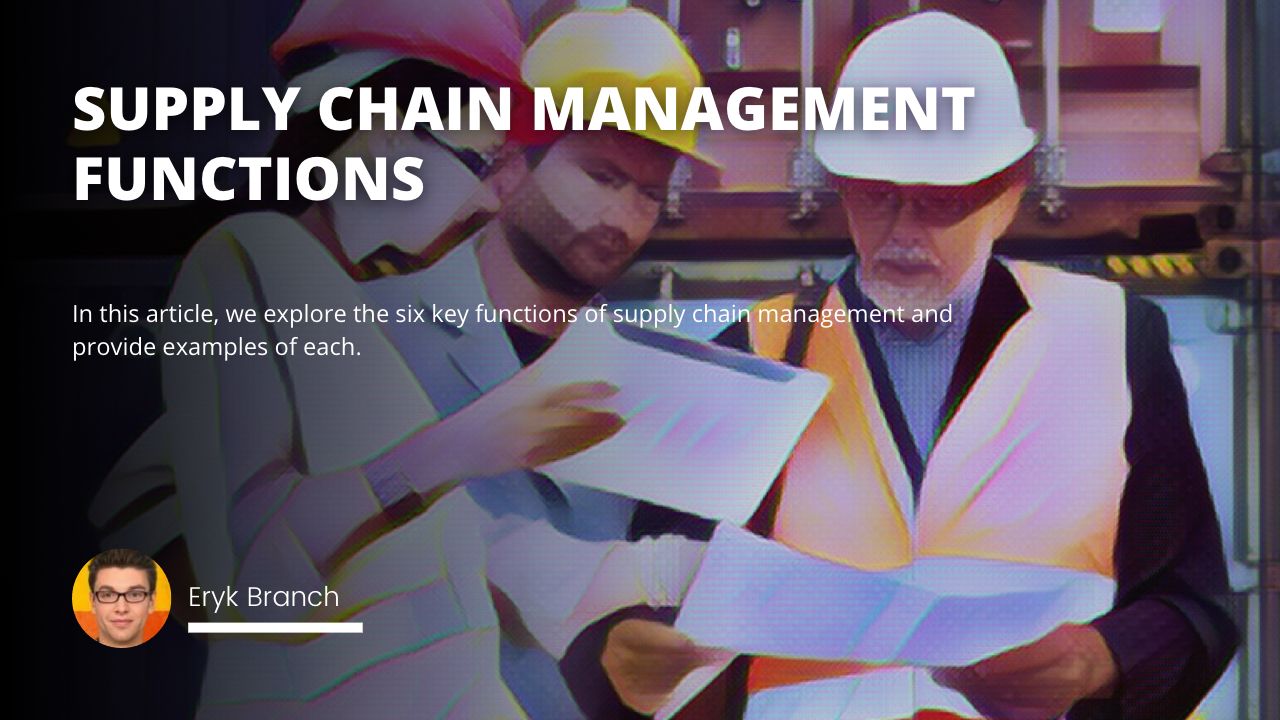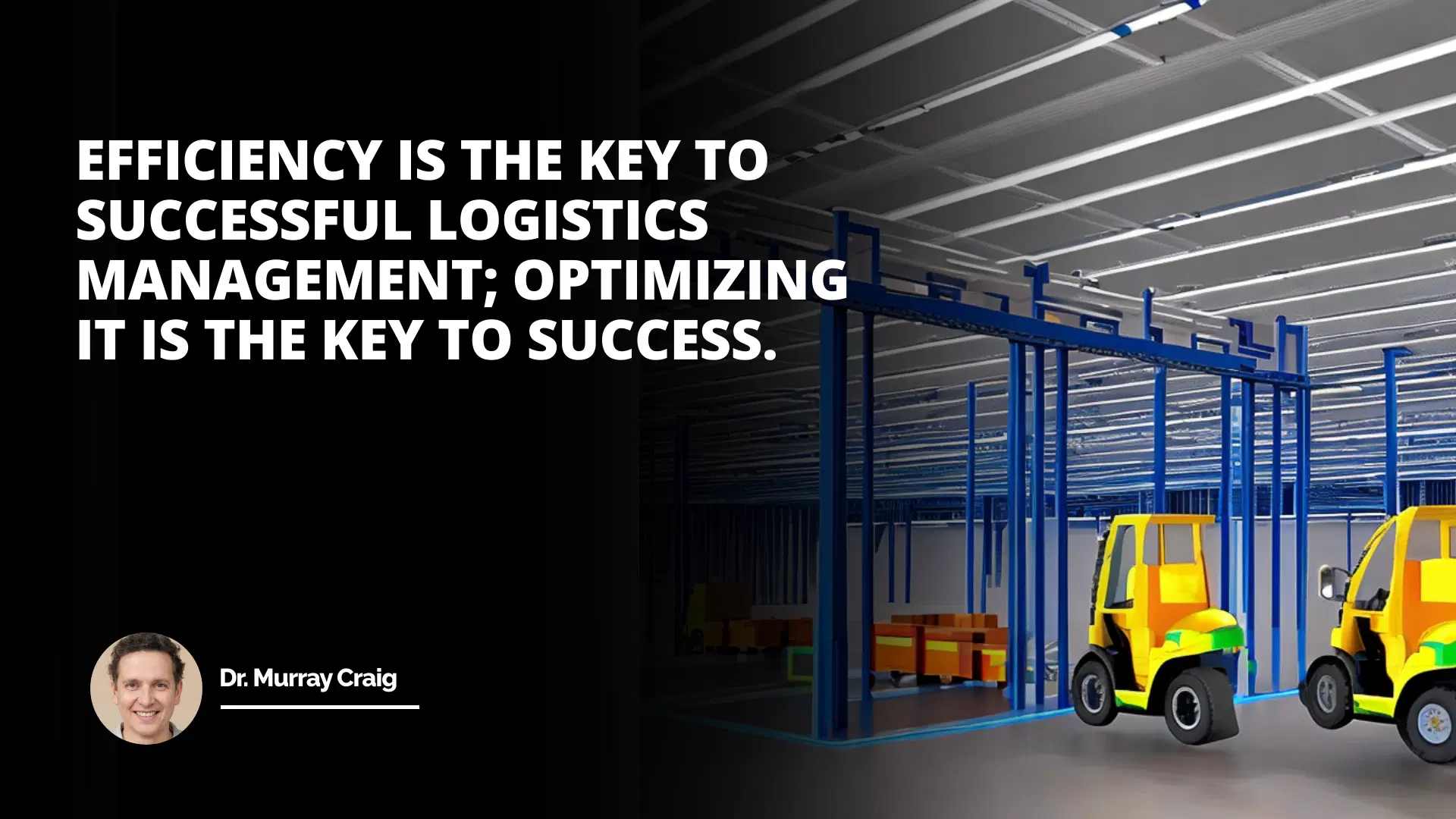
With the hum of machinery and the constant buzz of activity, the warehouse floor always felt like a living organism to me. I remember the early days when I first stepped into the world of logistics management. The sheer scale of operations was overwhelming, but there was an undeniable rhythm to it all. It was clear that efficiency wasn't just a buzzword here—it was the lifeblood of the entire operation.
Logistics management is more than just moving goods from point A to point B. It's about orchestrating a complex symphony of processes, people, and technology to deliver products and services where they're needed, precisely when they're needed. Over the years, I've learned that optimizing this intricate dance isn't just beneficial—it's essential for any business aiming to thrive in today's competitive market.
Introduction to Logistics Management
Establishing Clear Objectives
Streamlining Processes
Leveraging Technology
Benefits of Optimizing Efficiency
The Journey Begins: Understanding Logistics Management
When I think back to my first role in the supply chain sector, I recall being amazed by the interconnectedness of it all. Every department, from procurement to distribution, played a critical role in the success of the operation. Supply chain management wasn't just a job—it was a strategic function that could make or break a business.
In essence, logistics management is about planning, implementing, and controlling the efficient flow and storage of goods, services, and related information. It's a crucial part of supply and chain management, ensuring that every link in the chain is strong and functioning optimally.
Establishing Clear Objectives: The Compass of Success
One of the first lessons I learned was the importance of setting clear objectives. Without a defined direction, it's like navigating a ship without a compass—you'll end up drifting aimlessly. I recall a time when our company faced significant delays due to a lack of clear targets. Shipments were late, costs were soaring, and customer satisfaction plummeted.
We decided to regroup and set specific, measurable, achievable, relevant, and time-bound (SMART) objectives. We aimed to reduce delivery times by 20% within six months and cut transportation costs by 15% in the same period. By establishing these clear goals, we could align our team and resources effectively. It's amazing how setting the right objectives can transform an operation from chaotic to streamlined.
Key steps in establishing clear objectives include:
1- Assessing current performance: Understand where you stand to know where you need to go.
2- Engaging stakeholders: Involve everyone from management chain supply to ground-level staff.
3- Defining metrics for success: Determine how you'll measure progress.
4- Communicating goals clearly: Ensure everyone knows the objectives and their role in achieving them.
5- Reviewing and adjusting regularly: Objectives should evolve with changing circumstances.
Streamlining Processes: Cutting Through the Noise
Once we had our objectives laid out, the next step was to look inward and evaluate our processes. It's astounding how many redundant or outdated procedures can clog up an operation. I remember conducting a comprehensive process audit with my team. We spent days mapping out each step, from intake to delivery.
Efficiency is the key to successful Logistics Management; optimizing it is the key to success.

We discovered that several approval stages were unnecessary, causing delays. By eliminating non-value-added activities, we streamlined our workflow significantly. We also standardized procedures across departments, which reduced confusion and errors.
Strategies for streamlining processes include:
Mapping out workflows: Visual diagrams can help identify bottlenecks.
Implementing the 5S methodology: Sort, Set in order, Shine, Standardize, Sustain.
Automating repetitive tasks: Use technology to handle mundane activities.
Encouraging employee feedback: Those on the front lines often have the best insights.
Conducting regular training: Ensure everyone is up-to-date on best practices.
Leveraging Technology: The Power of Innovation
In today's digital age, technology is a game-changer in logistics. Back in the day, we relied heavily on manual entries and paperwork, which were prone to errors and inefficiencies. Transitioning to an integrated logistics management system (LMS) revolutionized how we operated.
We incorporated tools such as warehouse management systems (WMS) and transportation management systems (TMS). These platforms allowed us to track inventory in real-time, optimize routes, and reduce waste. I vividly remember the first time we used predictive analytics to anticipate demand. It felt like we had a crystal ball!
Technological solutions that can enhance logistics efficiency:
1- Automation and Robotics: For handling and sorting goods.
2- Internet of Things (IoT): Connecting devices for seamless communication.
3- Blockchain Technology: For secure and transparent transactions.
4- Artificial Intelligence (AI): For data analysis and decision-making.
5- Cloud Computing: For scalable and accessible data storage.
The Human Element: Focusing on Customer Service
While technology and processes are critical, we mustn't forget the human element. At the heart of logistics is the customer. Early in my career, I made the mistake of focusing too much on internal efficiencies and not enough on customer satisfaction. It wasn't until we started receiving complaints that I realized the gap.
We shifted our focus to provide exceptional customer service. This involved training our staff to be more responsive, implementing feedback mechanisms, and ensuring timely communication. By nurturing relationships with our clients, we built trust and loyalty, which translated into repeat business and positive referrals.
Implementing Cost-Saving Measures: The Bottom Line Matters
Efficiency isn't just about speed and quality—it's also about cost-effectiveness. One of the challenges we faced was balancing service excellence with budget constraints. We conducted a detailed cost analysis, looking at everything from procurement to delivery.
Through techniques like bulk purchasing, negotiating better rates with carriers, and reducing energy consumption, we managed to cut costs without compromising on quality. It's like my old mentor used to say, "A penny saved is a penny earned, especially in supply chain mgmt."
Developing a Culture of Continuous Improvement
Perhaps the most significant lesson I've learned is that efficiency isn't a destination—it's a journey. Adopting the philosophy of Continuous Improvement, or Kaizen, we fostered an environment where every team member was encouraged to seek better ways of doing things.
We held regular workshops, encouraged suggestions, and celebrated small wins. This culture not only improved our operations but also boosted morale and engagement among staff. After all, when everyone is rowing in the same direction, the boat moves faster.
The Ripple Effect: Benefits of Optimizing Efficiency
Optimizing efficiency in logistics management has far-reaching benefits:
Improved Customer Satisfaction: Faster, more reliable deliveries enhance the customer experience.
Reduced Operational Costs: Streamlined processes minimize waste and save money.
Competitive Advantage: Efficiency sets you apart in a crowded market.
Better Employee Engagement: Efficient systems reduce frustration and increase job satisfaction.
Higher Profit Margins: Efficiency contributes directly to the bottom line.
Real-World Example: The Critical Path Method in Project Management
I recall a project where we had to overhaul our distribution network. The timeline was tight, and the stakes were high. We employed the critical path method project management strategy to identify the most crucial tasks and allocate resources effectively.
By focusing on critical activities that directly impacted the project's completion time, we managed to stay on schedule. This experience reinforced the importance of strategic planning and resource management in logistics.
Conclusion: Embracing the Future of Logistics Management
Looking back, the journey to optimize efficiency in logistics management has been both challenging and rewarding. By focusing on clear objectives, streamlining processes, leveraging technology, prioritizing customer service, implementing cost-saving measures, and fostering a culture of continuous improvement, we transformed our operations.
The world of supply chain and logistics is ever-evolving. With globalization and technological advancements, the stakes are higher than ever. But with the right strategies and a commitment to excellence, businesses can not only survive but thrive.
Key takeaways:
Set Clear Objectives: Know where you're going to map out the path.
Streamline Processes: Cut out the unnecessary to make room for efficiency.
Leverage Technology: Embrace innovation to stay ahead.
Focus on the Customer: They are the reason we exist.
Implement Cost-Savings: Be smart about spending.
Cultivate Continuous Improvement: Never stop striving for better.
In the end, optimizing efficiency isn't just about systems and processes—it's about people, purpose, and passion. It's about harnessing the collective effort of every individual in the supply chain management to deliver value. And that, to me, is the true essence of successful logistics management.
References
1- Chopra, S., & Meindl, P. (2016). Supply Chain Management: Strategy, Planning, and Operation. Pearson Education.
2- Rushton, A., Croucher, P., & Baker, P. (2017). The Handbook of Logistics and Distribution Management. Kogan Page Publishers.
3- Goldratt, E. M. (1997). Critical Chain. The North River Press.
4- Ballou, R. H. (2004). Business Logistics/Supply Chain Management. Pearson Education India.
5- Liker, J. K. (2004). The Toyota Way: 14 Management Principles from the World's Greatest Manufacturer. McGraw-Hill.
Frequently Asked Questions
What are the key objectives of Logistics Management and how can they be established?
The key objectives of Logistics Management are to ensure that goods and services are delivered in a timely manner, at the lowest possible cost, with the highest possible quality and reliability. These objectives can be established by setting clear goals and expectations, streamlining processes to reduce inefficiencies, leveraging technology to automate processes, and focusing on customer service. Additionally, cost-saving measures should be implemented, such as negotiating better rates with suppliers, and a culture of continuous improvement should be developed to ensure that operations remain as efficient as possible. By taking the time to properly manage logistics, businesses can ensure that they are making the most of their resources and maximizing their productivity.
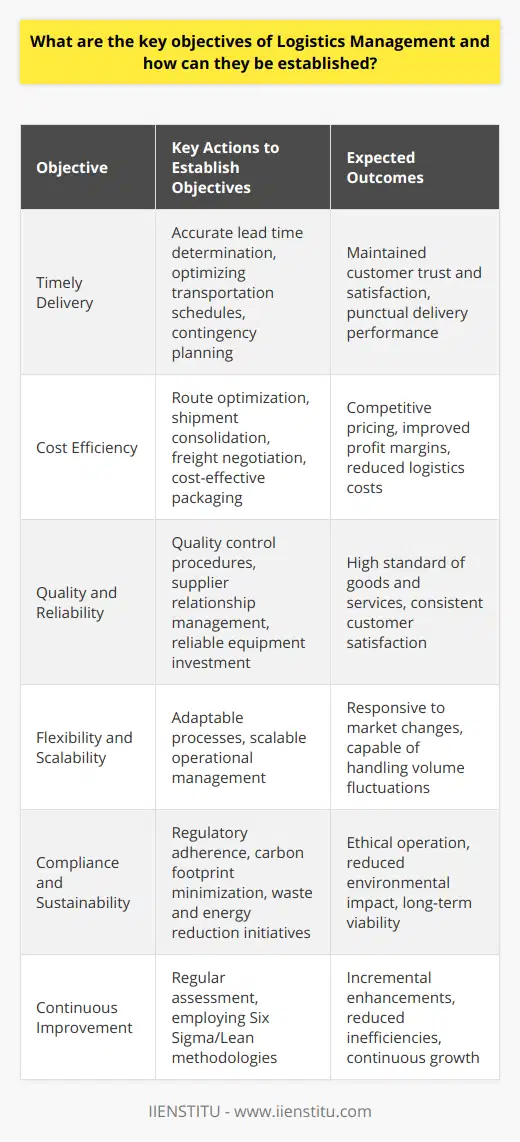
What processes can be streamlined to optimize efficiency in Logistics Management?
In order to optimize efficiency in logistics management, businesses should focus on streamlining processes. This includes establishing clear objectives, leveraging technology, and focusing on customer service. Cost-saving measures should also be implemented, and a culture of continuous improvement should be developed to encourage ongoing optimization. By taking the time to properly manage logistics, businesses can ensure that their operations are running as efficiently as possible.
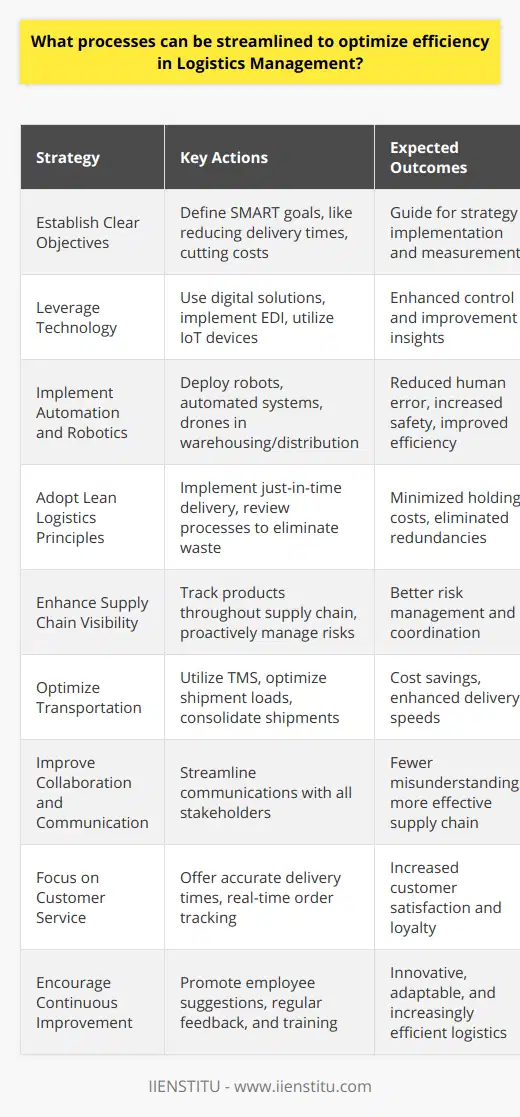
How can technology be leveraged to improve efficiency in Logistics Management?
This article highlights the importance of optimizing efficiency in logistics management in order to ensure that businesses are running as efficiently as possible. It discusses the benefits of streamlining processes, leveraging technology, focusing on customer service, implementing cost-saving measures, and creating a culture of continuous improvement. Through a proper management of logistics, businesses can leverage technology to improve efficiency and ensure that their operations are running optimally.
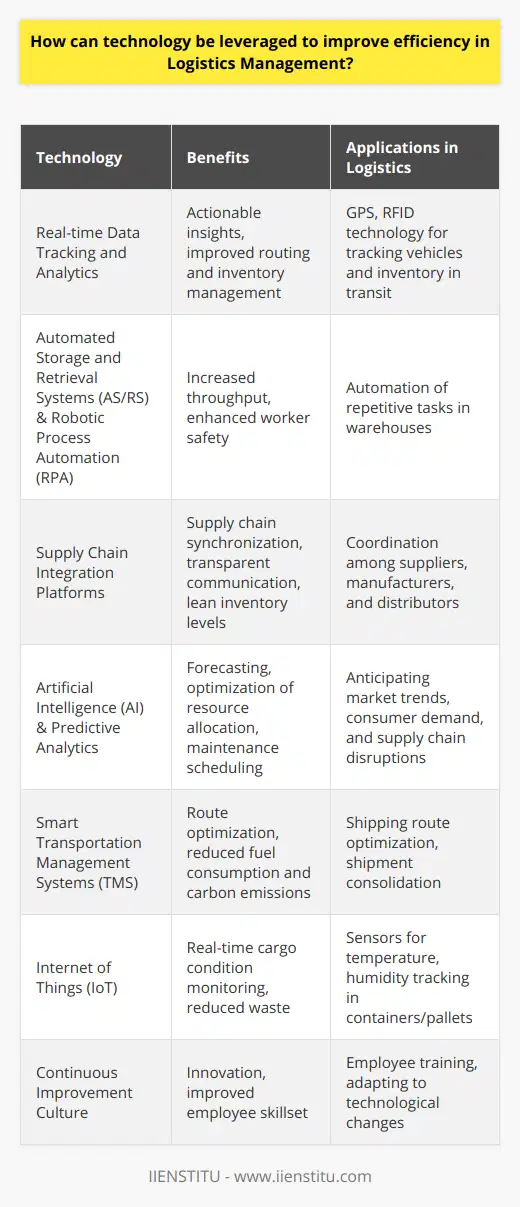
How can supply chain visibility and collaboration contribute to logistic efficiency improvement?
Role of Supply Chain Visibility in Efficiency Improvement
Supply chain visibility plays a crucial role in improving logistics efficiency. By providing real-time information on the location, status, and condition of products throughout the supply chain, visibility enables companies to make better-informed decisions. Additionally, it allows organizations to identify bottlenecks and inefficiencies and adapt their processes accordingly. This results in increased operational efficiency, enhanced customer satisfaction, and reduced costs.
Collaboration Importance in Supply Chain Efficiency
Effective collaboration among all parties involved in the supply chain, including suppliers, manufacturers, logistics providers, and customers, is essential for achieving logistics efficiency. Collaboration allows for better coordination, reduced redundancies, faster response times, and streamlined communication. The sharing of resources, knowledge, and capabilities among partners enhances the overall performance of the supply chain, leading to increased efficiency and reduced costs.
Integrated Technologies for Optimal Results
Integration of technologies such as Internet of Things (IoT), radio-frequency identification (RFID), and advanced analytics contribute significantly to improving supply chain visibility and collaboration. IoT enables real-time data collection and monitoring of products, reducing errors and enabling faster decision-making. RFID technology allows for instant inventory tracking, improving both traceability and efficiency. Advanced analytics helps organizations derive valuable insights from the data collected, promoting proactive decision-making and contributing to logistics efficiency.
The Importance of Adoption and Adaptation
Embracing supply chain visibility and collaboration initiatives requires organizations to adopt new technologies and adapt to changes in their business processes. The smooth implementation and optimization of these initiatives are essential for realizing the full potential of their benefits. Organizations must invest in training and education to ensure all relevant stakeholders are knowledgeable about the new systems and processes, enabling more effective collaboration and higher levels of supply chain efficiency.
In summary, supply chain visibility and collaboration are critical factors in improving logistics efficiency. Through the integration of advanced technologies, effective communication among stakeholders, and a willingness to adapt to new systems and processes, organizations can significantly enhance their supply chain performance to better meet customer demands and optimize their operations.
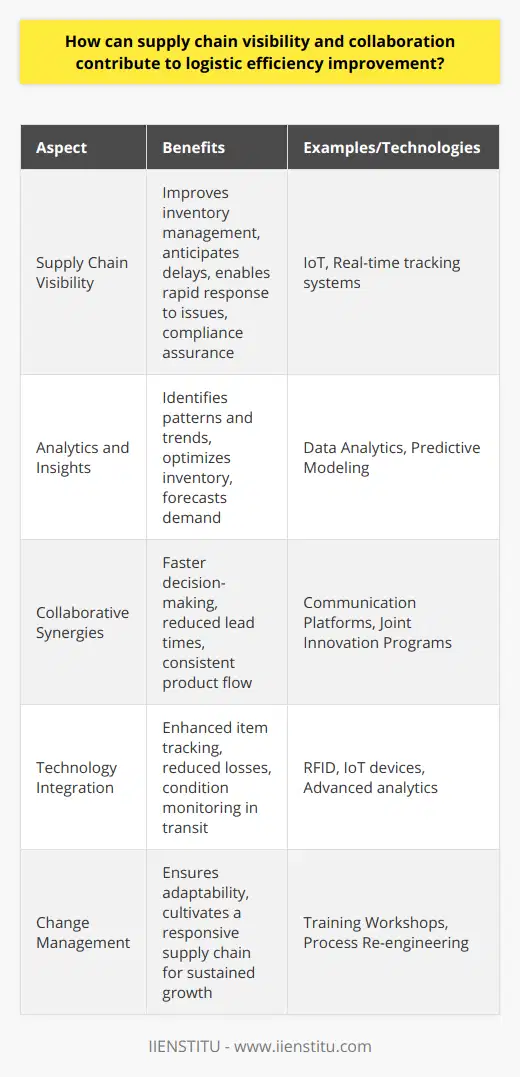
What role does data analytics play in optimizing logistic processes?
Role Identification
Data analytics plays a pivotal role in optimizing logistic processes by analyzing vast amounts of structured and unstructured data to identify patterns, trends, and opportunities. This analysis ultimately enhances the efficiency, visibility, and effectiveness of logistical operations across the supply chain.
Efficiency Enhancement
One primary role data analytics serves in optimizing logistic processes is improving efficiency. By analyzing historical data, such as shipment records and delivery times, data analytics can help organizations identify bottlenecks, inefficiencies, and areas for potential improvement in their operations. Implementing data-driven strategies then improves overall productivity and resource utilization, reducing costs, and increasing profit margins.
Visibility Improvement
In addition to enhancing efficiency, data analytics also helps improve visibility throughout the supply chain. Real-time data collection and analysis enable organizations to monitor and track goods, shipments, and inventory levels effectively. These insights facilitate better decision-making, reduce risks associated with inventory management, and provide valuable information for transportation management, demand forecasting, and capacity planning.
Effectiveness Augmentation
Another critical role data analytics plays in optimizing logistic operations is augmenting effectiveness. Leveraging predictive analytics, organizations can anticipate potential disruptions, such as equipment breakdowns, weather-related delays, or supplier issues, and proactively develop contingency plans. This proactive approach allows for a more flexible and agile supply chain, minimizing the impact of disruptions on logistics processes.
Cost Reduction
Lastly, data analytics can significantly contribute to cost reduction in logistics processes. The optimization of transportation routes, capacity utilization, and inventory management, all driven by data insights, leads to a decrease in operational costs. Furthermore, predictive maintenance using IoT devices and data analysis can reduce repair and maintenance expenses by identifying potential issues before they escalate into major problems.
Conclusion
In conclusion, data analytics serves as a vital tool in optimizing logistics processes by enhancing efficiency, improving visibility, augmenting effectiveness, and reducing costs. As the world becomes increasingly data-driven, organizations that leverage data analytics in their logistics operations will undoubtedly experience competitive advantages over those who do not.
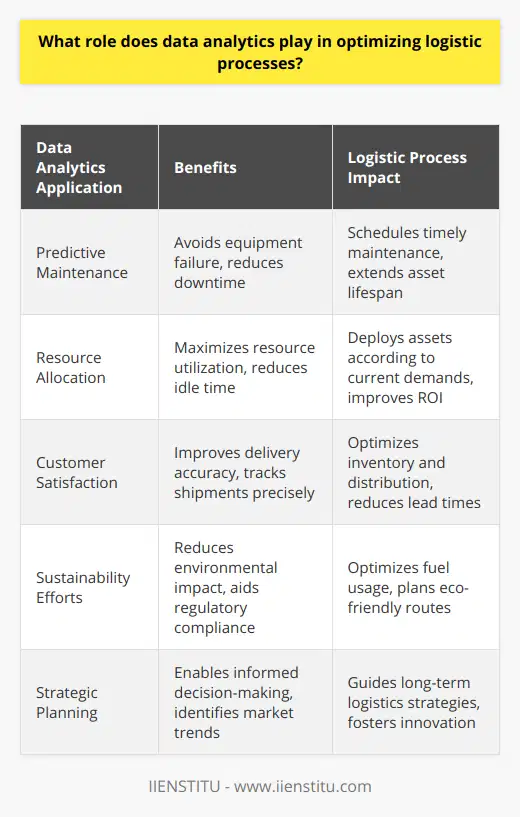
How can the implementation of the 7 R's improve decision-making and reduce costs in logistics management?
**Enhancing Decision-Making Through the 7 R's**
The application of the 7 R's in logistics management bolsters decision-making processes and trims expenses. Deep-seated in supply chain management, the 7 R's comprise the right product, right quantity, right condition, right place, right time, right customer, and right cost. Emphasizing these aspects fosters efficiency in operations, diminishes waste, and boosts customer satisfaction.
**Optimizing Resource Utilization**
By implementing the 7 R's, organizations can optimize resources by ensuring the apt allocation of materials, labor, and capital. Logistics managers can determine the appropriate products to stock, which caters to changing consumer preferences, and the corresponding inventory levels needed to meet demand. As a result, firms can minimize excess inventory and storage costs while abating the risk of stockouts.
**Improving Information Flow**
Enhanced decision-making is facilitated by reliable and timely information. Examining the 7 R's prompts organizations to evaluate information systems and frameworks that underpin logistics processes. Proper data management, sharing, and analysis enable managers to make informed decisions that lower costs, achieve operational targets, and respond to evolving market conditions.
**Reducing Costs through Efficiency**
Employing the 7 R's allows businesses to sys tematically assess their logistics processes, identifying areas of redundancy and inefficiency. By analyzing the right condition, place, and time, logistics managers can pinpoint transport and handling measures that are cost-effective and relevant to the specific product. Consequently, ensuring delivery of goods in pristine condition to the desired location without delays augments customer satisfaction and loyalty while reducing unnecessary expenses.
**Customer-Centric Logistics Management**
Exceeding customer expectations is pivotal in today's competitive market. Implementing the 7 R's directs logistics managers to shift their focus to customer needs, guaranteeing delivery of their desired product at the right cost. Through evaluating customer preferences and desires, companies craft tailored logistics solutions fostering higher customer satisfaction rates, fortifying long-term relationships, and bolstering their position in the market.
In conclusion, the implementation of the 7 R's immensely enhances decision-making processes in logistics management and reduces costs. By focusing on resource optimization, improving information flow, amplifying efficiency, and maintaining a customer-centric approach, organizations can successfully achieve streamlined operations, heightened customer satisfaction, and fortified market competitiveness.
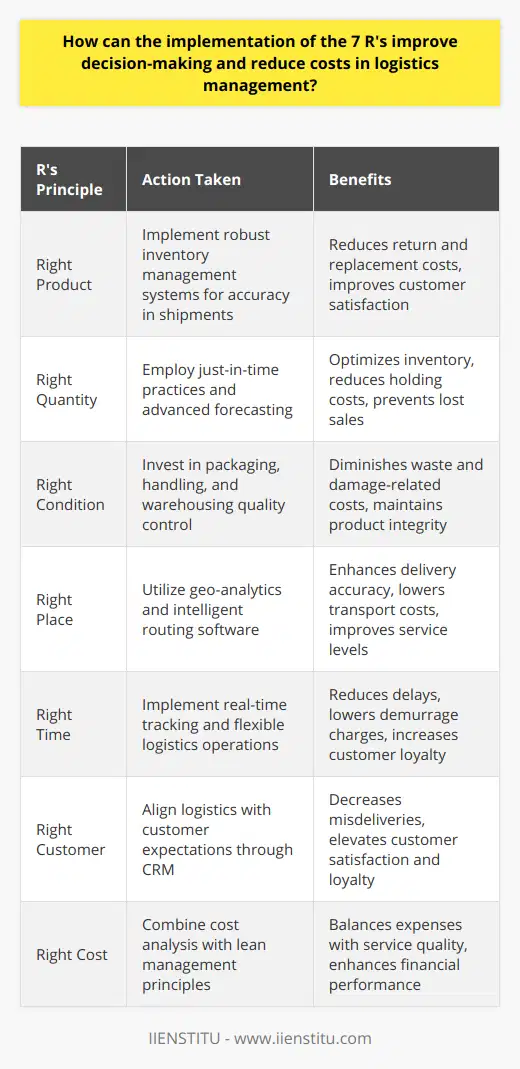
How can logistic efficiency be improved through transportation and inventory management?
Optimization of Transportation Strategy
Improved logistics efficiency can be achieved by optimizing transportation strategies. This involves selecting the most cost-effective and efficient means of transporting goods. For example, freight consolidation - combining smaller shipments into one large shipment - can result in cost savings and improved efficiency.
Incorporating Tech into Transport
The application of technology in transportation can also enhance logistic efficiency. GPS systems allow for real-time tracking, while route optimization software can devise the most efficient paths, thereby reducing costs and improving delivery times.
Adopting a Lean Inventory Approach
Efficient inventory management can also boost logistic efficiency. Adopting a lean inventory approach, the focus is on keeping only necessary stock and eliminating waste. This approach reduces storage costs and the risk of goods becoming obsolete.
Inventory Forecasting
Thorough forecasting of inventory demand based on historical data can aid in avoiding under or overstock. This proactive approach can reduce costs associated with storing unnecessary items or making emergency purchases to meet unforeseen demand.
Rethinking Packaging
Finally, rethinking packaging can help improve logistics efficiency. Efficient packaging reduces wasted space in transport vehicles and warehouses, contributing to cost-effectiveness and improved utilization of storage and transportation capacities.
In conclusion, optimizing transportation strategies, embracing technology, adopting a lean inventory approach, forecasting inventory demand, and efficient packaging can significantly enhance logistic efficiency. These measures can cut costs, reduce waste, improve customer satisfaction, and ultimately contribute to a more sustainable and efficient logistics operation.
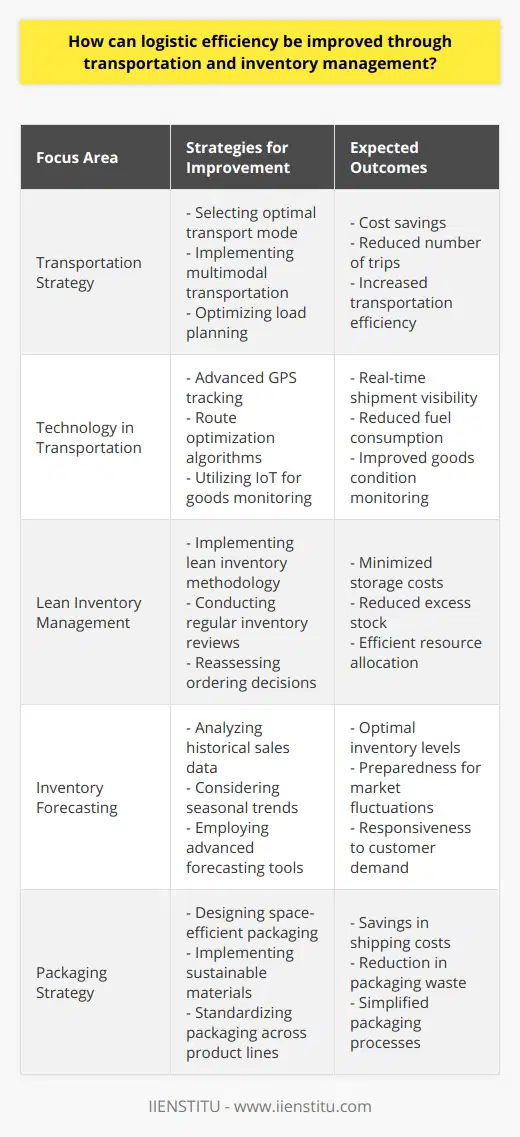
What are the implications of adopting green logistics practices on overall efficiency?
Enhancement of Efficient Operations
Adopting green logistics can enhance overall efficiency. These practices involve resource optimization, yielding lower operational costs. Adopting sustainable transport modes and improving route efficiency can reduce fuel consumption.
Improved Brand Image and Market Positioning
Green logistics also strengthen the company's image, influencing consumer behavior and market positioning. Companies adopting these practices demonstrate corporate social responsibility, which can attract eco-conscious customers and investors.
Waste Reduction and Conservation
Adoption of green logistics leads to significant waste reduction. These practices aim to minimize waste throughout the supply chain, fostering a circular economy. Companies, thereby, maximize resource use and minimize environmental impact.
Regulatory Compliance
Green logistics ensure regulatory compliance. Many countries impose stringent environmental regulations. These practices empower companies to satisfy these legal requirements. Non-compliance can result in hefty penalties and damages to the company’s reputation.
Future-proofing Business
Green logistics make businesses future-proof by gearing them for emerging trends and challenges. The global market shift towards sustainability means companies resisting this transition may face competitive disadvantages.
In summary, green logistics have manifold implications for overall efficiency. They can streamline operations, strengthen market position, reduce waste, ensure regulatory compliance, and future-proof businesses. Therefore, companies must prioritize integrating these practices into their operations, securing both environmental sustainability and business viability.
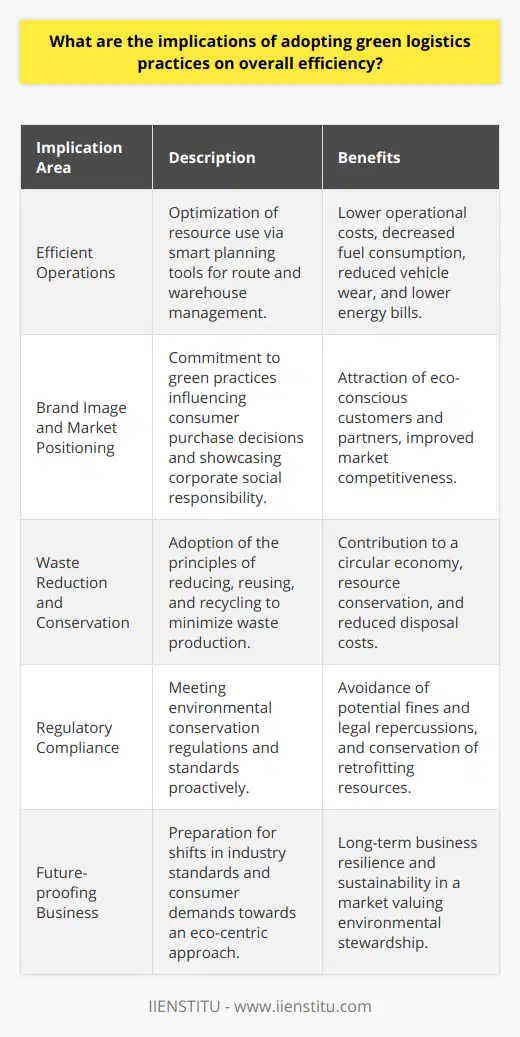
How does implementing risk management strategies contribute to an optimized logistics operation?
Risk Management and Optimized Logistics
Implementing risk management strategies significantly contributes to optimizing logistics operations. These strategies help to identify possible threats in logistics operations. The early identification of potential risks promotes proactive planning, instead of reactive problem-solving.
Risk Management Enhances Control
Effective risk management strategies offer enhanced control over logistics processes. By critically analyzing all elements of the logistics chain, management can predict potential problems. This predictive ability can aid in avoiding waste, minimizing unnecessary expenses and promoting process efficacy. Such control contributes greatly to achieving seamless operations, reducing operational costs, and providing room for flexibility.
Risk Management Facilitates Decision Making
Risk management also facilitates better decision making in logistics operation. Decision makers can use risk assessment results as significant input when devising action plans. Better informed decisions lead to optimized logistics operations that further enhance business growth and profitability.
Risk Management Boosts Operational Efficiency
Moreover, risk management boosts operational efficiency within logistics. Proactively managing risks helps reduce delays, minimizes errors, and prevents financial losses, all contributing to overall efficiency. Furthermore, it promotes sustainability by avoiding potential catastrophic disruptions and enabling smooth operations.
Risk Management Fosters Customer Satisfaction
Finally, strong risk management leads to customer satisfaction. With minimal disruptions and delays in the supply chain, customers receive their orders on time, fostering their loyalty and overall satisfaction.
In conclusion, integrating risk management strategies is a vital aspect in optimizing logistics operations. It offers better control, enhances decision making, boosts operational efficiency, and increases customer satisfaction. Therefore, companies must prioritize implementing risk management in order to achieve optimum logistics performance.
